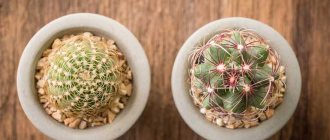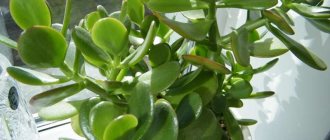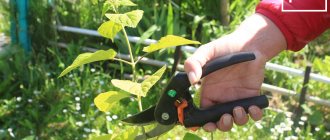Features of cacti as plants
These representatives of the flora belong to succulent plants. That is, they are able to accumulate moisture in their powerful stem. Unlike other green organisms, they do not have leaves. The shoots are covered with hard or soft spines involved in photosynthesis.
The Cactus family is numerous, with over 2 thousand species, which are combined into 300 genera. America is considered the birthplace and main place of growth. Mexico, Chile, Argentina, Sri Lanka are rich in various species. They grow in arid desert areas and tropical jungles. Succulents survive in extreme conditions.
The trunk, also called the body, can grow to enormous sizes in the wild. The height of the stems sometimes reaches 10 m. The highest height recorded by scientists was 19 m.
The shoots grow very slowly, the annual growth is usually small. Along with giant succulents, there are also miniature specimens. The diameter of the Blossfeldia cactus reaches 1 cm.
Thorns are needed not only for protection from predatory animals, but also for protection from the sun. No matter how thick the spines are, they cast a shadow on the trunk. The thicker the layer the shoots are covered, the higher the preparedness for the scorching sun.
The skin is dense, practically impermeable to gases and liquids. Pubescence often plays the role of an absorbent sponge.
Another interesting feature of most species is that the thorny bushes do not form inflorescences; the flowers do not have a peduncle. The flower acts as a continuation of the stem. With excess feeding, some growing buds change into babies.
Flowering for these representatives of the flora is an unstable phenomenon. Some specimens bloom annually, others very rarely and only under very favorable conditions.
Some varieties are covered with flowers all over the top, creating a cap. The duration of flowering also varies. While some specimens have flowers that last for several weeks, others may close after a few hours.
Depending on the species, plants take on different shapes. The trunks are wrinkled, with ribs and tubercles. The ribs can be pronounced or barely noticeable, smooth or spiral-shaped. Plants are covered with different spines: dense, sparse, long, short, soft or hard.
A person needs to be careful with thorns. The needles can prick, and in some species they are a source of poison.
Discocactus horstii
This species grows in small areas in the mountainous regions of Brazil at an altitude of 1,800 to 2,000 meters above sea level. Discocactus horstii generally takes root in sandy soils and quartz gravel.
A small cactus with a segmented trunk does not grow more than 5 cm in height, but the diameter of the stem can vary from 2 to 8 cm. Flowers bloom only at night and only in summer. When blooming, it emits an incredible aroma, and the flower itself is mostly white.
Since there is little moisture in rocky soils, Discocactus horstii has adapted to absorb moisture from the air with its thorns and its numerous needles.
Varieties and their distinctive features
Compact varieties bred through selective breeding are grown indoors. Today the choice of dwarf specimens is huge. Those cacti that grow in natural conditions differ from domestic inhabitants.
Desert cacti
Desert succulents are particularly resistant to heat and drought. The trunk and spines are adapted to the shortage of important components. With a lack of moisture, the ribs of the shoots become almost invisible, and after rains they acquire distinct outlines.
The root system of desert species adapts to external conditions. Depending on the circumstances, the roots accumulate moisture, contract or go deeper into the soil. Small roots can grow above the surface, collecting dew.
Unique adaptive properties have allowed succulents to survive for many centuries.
The most common desert cacti include Astrophytums, Mammillarias, Ariocarpus, Loffophora, Cephalocereus.
Forest cacti
Forest species differ from desert inhabitants and are more demanding of living conditions. Plants need high humidity and diffused light.
Forest succulents prefer to be located in trees, feeding on decomposition. They are also placed in rock crevices, catching on stones. Thanks to aerial roots they obtain moisture for themselves.
Externally, forest species differ from the usual representatives of the family. The shoots of the plants are elongated, hanging down, and the spines are more like bristles or hairs. Rhipsalis, Aporocactus, and Epiphyllum have become widespread.
Home cacti
Domestic species are represented by flowering and non-flowering species. Flowering is always spectacular and colorful. Among the adapted varieties there are specimens of a wide variety of forms. Non-flowering species are also attractive and have decorative properties.
Rebutia, Cereus, Notocactus, Echinocactus, Cephalocereus and many others have gained popularity as indoor plants.
Mammillaria
The list, which includes decorative and miniature cacti, continues with Mammillaria, the largest genus of cacti, numbering more than 180 species.
The most adapted to dry climate type of cacti, the stem of which grows from 1 to 20 cm in diameter and from 2 to 40 cm in height. The stems can have a spherical or oblong shape, but the flowers, growing up to 8 mm, have a yellow color with a reddish tint petals.
Mammillaria grow in southern Mexico, but some species have chosen the expanses of the southwestern United States, as well as the rocky areas of Venezuela, Colombia and Honduras.
Methods for growing cacti at home
Cacti can be propagated at home in different ways. Each has its own characteristics and advantages.
Seating of children (shoots)
The small, spiny shoots on the plant are called pups. These parts take root and grow well. Reproduction by this method is considered one of the simplest and most effective. It is believed that the strongest shoots are at the top of the cactus, while weaker specimens grow near the ground.
Even an inexperienced amateur can handle planting shoots. However, this method also has a drawback. Flower growers have noticed that each next generation raised from children becomes weaker. Plants are degenerating.
Cuttings
Most indoor plants reproduce in this way. The method is quite simple and effective. However, getting the segment is not so easy. There is a technology for cutting the cuttings and processing them. The cut fragment is left to lie for several days. This is followed by a long rooting phase. The cutting takes root no earlier than after 30-60 days.
Graft
Vaccination is needed in certain situations:
- root rotting
- long absence of flowering
- inability to reproduce in any other way
The method is complex and does not always give the desired result. After all, every living organism tries to get rid of a foreign fragment. The best time for the procedure is early summer.
For the event to be successful, the plant being vaccinated must be young and completely healthy, and also have a developed root system.
During the fusion period, it needs special conditions - warmth and humidity.
Planting seeds
When it comes to seed germination, cactus is called one of the most capricious plants. Growing a full-fledged prickly plant from a seed is quite a task. However, some gardeners still prefer this method.
Unlike other plants, cactus seeds cannot simply be buried in the ground - otherwise they will not germinate. In small greenhouses, beds are organized, at the bottom of which drainage is placed, previously scalded with boiling water.
Calcined sand is poured on top. Seeds will germinate only in conditions of high temperature (about 30 C) and humidity. The container is covered with glass or film and placed on the southern windowsill. The emerging sprouts will have to be handled very carefully.
Not all breeding methods are simple and quick. Fans of thorny plants most often resort to two methods: planting babies and cuttings.
Espostoa
A small fluffy cactus native to Peru, it received its name in honor of the director of the wonderful botanical garden in Lima, Peru, Nicolas Esposto.
This natural “fluffy plant” belongs to a large family, and now science knows more than 10 varieties of this unique plant. Under natural conditions they grow on rocky mountain slopes, but in gardeners’ collections some species do not grow more than 12 cm.
Because of its unusual appearance, it is often called the white cactus and cotton cocoon. There's just such a handsome guy growing up in the biggest editor's office!
How to properly plant a cactus with children
Seating children is the most acceptable method for a beginner. Suitable for those types of cacti that form these shoots. In some species they fall off on their own and take root after a while.
Children without roots are first placed in the substrate. Specimens with developed roots are planted directly in the ground.
Before planting a new young specimen in a pot, the children are rooted. The cut fragment is first slightly dried on a clean sheet of paper. To do this, be sure to choose a dark place.
The wider the cut area, the longer the process takes to dry. It takes at least 1-2 days for a dry callus to appear. If the children fall off on their own, rooting begins immediately. There are two ways to do this.
Placement in substrate
For rooting, take a small pot, which is only a couple of centimeters larger than the diameter of the shoot itself. During the process, it is very important that the water does not stagnate, otherwise the cut will rot. Therefore, the container must have drainage holes.
A slightly moist sandy mixture is used as soil (2 parts sand to 1 part soil). The spiny shoot is carefully applied with a cut to the surface. Please note that the section is not buried or covered with soil.
Watering is carried out especially carefully. A plant without roots easily moves and falls to the side. Perform the movements as carefully as possible, and do not move the pot until the roots appear. For stability, the baby is covered with small pebbles or vermiculite. Roots form after 7-12 days.
Rooting in a glass
Rooting directly in water is completely unsuitable. The cut rots long before roots form. There is an unusual rooting technology.
The shoot is attached to the glass so that the cut is at a distance of 5-6 cm above the water level. As water evaporates, carefully add water, bypassing the plant itself. The liquid temperature is maintained at 27-30 C.
The children are planted in pots after roots have formed. While the plants are small, one container is suitable for several specimens.
Agave Cactus
The Latin name of this beautiful cactus is Leuchtenbergia principis, and it is named after the Duke of Lichtenberg Maximilian Eugene Joseph, who was a great lover of wild plants.
Usually the stems are short, but with proper care they can reach 70 cm. Botany lovers are attracted by the unusual shape of the cactus, as well as magnificent flowers with a diameter of up to 6 cm, and having a wide range of colors.
Note that some types of Agave are used for the production of tequila, because the birthplace of this cactus is Mexico.
How to remove babies from a cactus and whether they need to be torn off
In order for the mother plant to remain healthy and the children to take root successfully, they should be removed correctly. Most people prefer to do this with tweezers. Under no circumstances try to remove the shoots with your hands.
It should be separated so that there are no pieces of the shoot left on the main trunk, and no pieces of the mother’s body left on the baby. Otherwise, rotting of the bush or separated fragment may occur.
To minimize the risk, gardeners recommend cutting off shoots with a sharp, disinfected knife.
If you are taking children for seating, use the following tips:
Wait until the growth reaches a size of 1.5-2 cm. A specimen that is too small will not be able to provide nutrition on its own and will dry out without ever taking root.
The most suitable time for reproduction is spring and early summer.
You can wait until the growth falls off on its own. You shouldn't wait longer than August. In autumn, the plant takes root worse.
Flowering is not a good time to reproduce.
Is it necessary to specifically cut off children? If you are not doing this for the purpose of reproduction, be guided by your taste. Sometimes a bald spot forms at the site of removal, which spoils the appearance. If the shoots grow throughout the trunk, the plant takes on an unusual appearance.
The need to cut off shoots appears when the plant becomes sick and begins to look bad. The bush will need strength and nutrition to recover.
Lophophora williamsii
The Indian tribes of Mexico and the USA call this plant Peyote, and used it to produce an alcoholic drink, which was used to induce trance during initiation rites.
A small cactus that does not grow more than 8 cm, has a spherical shape with smoothed ribs, and has no needles. The flowers appear at the top of the stem, and Peyote may produce several small flowers at a time.
Cultivation in Russia is punishable by law, and liability arises if more than two specimens of Lophophora williamsii are found in your home.
Do you have cacti at home? Yes, yes 69.23% No 30.77% Show results Voted: 13
How to plant a cactus shoot with roots
The shoots with roots are planted in a pot with soil. The landing technology is as follows.
When choosing a container for planting, pay attention to the material. Plastic containers cool less and retain moisture longer. A light color attracts the sun less and protects against overheating.
It is advisable to have drainage holes at the bottom. If there are none, do them yourself, or increase the thickness of the drainage layer. Containers with a small diameter stimulate the growth of the root system.
It is necessary to lay a drainage layer at the bottom, occupying a quarter of the container. Crushed brick or expanded clay will do. This technique removes excess moisture and protects the roots from rotting.
It is best to purchase a ready-made substrate. Instead of a store-bought mixture, combine chernozem, crushed dry leaves and river sand. The bush likes loose soil, so don’t try too hard to compact the soil.
A depression is made in the center of the container, where a young cactus with roots is planted. You cannot bury the bush deeply and press it down.
Although in the wild they have a powerful root system, houseplants are endowed with small roots. Subsequently, the adult plant is transplanted into a pot of larger diameter as it grows.
Notocactus ottonis
Many gardeners grow a unique cactus from the genus Parody because of its amazingly beautiful flowers, as well as the original structure of the stem.
The spherical stem with a diameter of 11 cm has from 8 to 12 ribs with radially arranged spines. It blooms with bright red flowers reaching sizes of 4–6 cm.
The plant's birthplace is considered to be Latin America, from where it spread throughout the world and became a magnificent decoration for residential premises and greenhouses.
Diseases
Most often, cacti get sick due to unfavorable living conditions . We list the most common diseases of cacti:
- Rot can be a consequence of excess moisture and the activity of fungi or bacteria. To prevent rot, keep the cactus dry and treat the seeds and soil before planting.
- The appearance of light spots on the stem is the result of the activity of mealworms. Treatment is treatment of the affected areas with a soap solution or karbofos.
- Yellowing of the stem is most often a consequence of the soil being poor in nutrients. Mineral fertilizers are recommended.
Cacti are wonderful plants, caring for which can give you a lot of pleasant emotions. Take care of your cactus correctly, and then you won't need to devote much time to it.
What does Pereskia look like, what family does it belong to?
Pereskia flowers are members of the Cactus family. Under natural conditions, they are distributed throughout Central and South America, in the form of a large shrub or small tree.
Pereskia spinosa
The culture has strong, straight stems covered with thorns. Reduced leaf blades are dark green in color; when the temperature drops to 10 degrees, they may fall off. With age, the leaves lose their bright color and turn pale.
Common varieties
The indoor flower varieties include the following representatives:
- Pereskia spinosa;
- Pereskia aculeata;
- Pereskia Godseff (godseffiana).
Important! The latter variety is distinguished by pinkish or purple lower leaves and a height of up to 10 m
Pereskia Godseffa
Obregonia denegrii
This pretty cactus is found in limited regions of the Valley of Mexico and is considered an endangered species. They were first discovered in 1923, and in 1925 its first scientific descriptions appeared.
The spherical stem has a diameter of up to 12 cm, and is completely covered with small, up to 1.5 cm, triangular papillae. It blooms with white flowers with a yellow core, but its seeds are black.
In addition to the Latin name, in English you can often find the trivial name Artichoke Cactus, and the Mexicans simply call the small plant Obregonita.
Gymnocalycium friedrichii
The second name of this incredibly beautiful plant is Gymnocalycium Michanovich, and the cactus blooms with funnel-shaped flowers of different colors, mostly white, pink and bright red.
The oblong stem contains up to 10 triangular ribs that do not contain villi. Gymnocalycium friedrichii grows no more than 10 cm and does not require special care.
A lot of bright light is required, but in summer it is better to protect the plant from direct sunlight.
Pereskiopsis spathulata
The fast-growing cactus is unique because in addition to thorns it also has leaves. It takes root very easily on any type of soil, and the optimal average temperature for growth is 12° C.
In general, many gardeners are always interested in the question of how to water cacti. So, such problems do not arise with Pereskiopsis spathulata, as the plant can easily withstand both abundant and infrequent watering.
But this species blooms very rarely, and in flower science it is used as grafting to accelerate the growth of other types of cacti.
Rating of hanging copies
Disocactus
Or, popularly, just a rat's tail. But, despite the unsightly nickname, it will become a real decoration of the home, which will be emphasized by an unusual hanging planter. And after a while, the vine-like lashes are covered with graceful scarlet buds, which will delight guests and apartment residents for a long time. The stems can grow up to 2.5 meters, filling all available space. This way you can create a unique green decoration. Unusual branches will certainly be appreciated by gardeners who want to give the room the ambiance of a fantastic planet.
As of 2022, aporocactus is also classified as the same species, since it does not have a rigid stem.
Disocactus
Advantages:
- An ideal solution for both home and office space;
- gift option;
- beautiful external data;
- can delight with flowering for a long time;
- does not require careful care.
Flaws:
- Not identified.
Christmas
Or Zygocactus Schlumberg, better known as Decembrist, is one of the favorite plants of experienced collectors and gardeners. An absolutely harmless option with soft stems and stunning round-shaped buds will delight you with its rich range of colors, dominated by:
- pink;
- red;
- white;
- orange;
- to soft purple.
Any shades can be ordered online. But although the flower is called a cactus, it has no needles. They are replaced by small areoles with barely noticeable hairs located along the edge of the leaf blade.
Zygocactus Schlumberg
Advantages:
- perennial;
- blooms in winter;
- prefers diffused lighting;
- beautiful external characteristics;
- completely harmless;
- it is ideal for creating a composition.
Flaws:
- To achieve flowering, certain conditions must be met;
- vulnerable root system.
Rhipsalis
Perhaps the most gentle among the mentioned brothers. It is a ball of green shoots elongated and twisted into a tube, which over time become covered with buds along the entire segment. The stems themselves are devoid of any shoots; they are quite thin and branched. Due to this feature, it is also known as the willow cactus. This unusually shaped flower will give the interior a special charm and gloss. Buds can be of different shades:
- white;
- pink;
- yellow.
This type will look great on a balcony or loggia.
Rhipsalis
Advantages:
- Able to delight with flowering for a long period;
- Great idea for a special gift;
- unpretentious;
- looks beautiful in a modern interior;
- survives cold well;
- easy to propagate;
- has barely noticeable soft needles.
Flaws:
- Does not like direct sunlight.
Rispalidopsis
It is also hatiora or Easter cactus. Outwardly it resembles Decembrist, but differs from it in the flowering period (early to mid-spring), as well as in more rounded stems. It has fleshy, hard, leafy segments. Where joints form, aerial roots often appear that can grow in the ground. The flowers have narrow, sharp petals; the following subspecies are relevant for 2022:
- The bushy pink rispalidopsis has a delicate shade and reaches a diameter of 5 cm.
- Creeping or branching variety of Gartner. It grows up to 15–20 cm and from April to May pleases with bright scarlet buds.
The flower will be an excellent decoration for a corridor, large hall or basement.
Rispalidopsis
Advantages:
- There are small berries;
- forms seeds;
- easy to propagate by cuttings;
- prefers moderate lighting
- the buds look like stars.
Flaws:
- The plant requires abundant watering;
- will burn if they are not periodically turned the other way.
Epiphyllum acupetallus
It is considered one of the forest brethren. The culture has graceful vines that almost touch the ground, presenting a stunning sight. Most often these are large white flowers, less often you can find buds of a crimson or pinkish hue. When a succulent is active, you should absolutely not move it from place to place. The most popular varieties of epiphyllum by 2022 are:
- Montrose - found in private collections due to its long, unusually curved stems. Which makes him look like a mythical creature.
- Hooker - has large, needle-like white heads.
Epiphyllum acupetallus
Advantages:
- Unusual external data;
- undemanding;
- he is immune to infections.
Flaws:
- When rearranged during activity, it can get rid of the bud.
- flowers bloom only at night.











